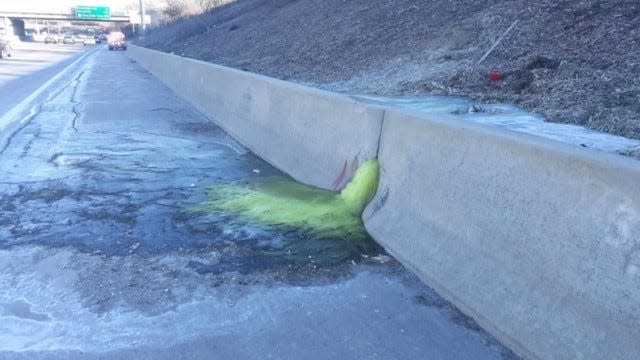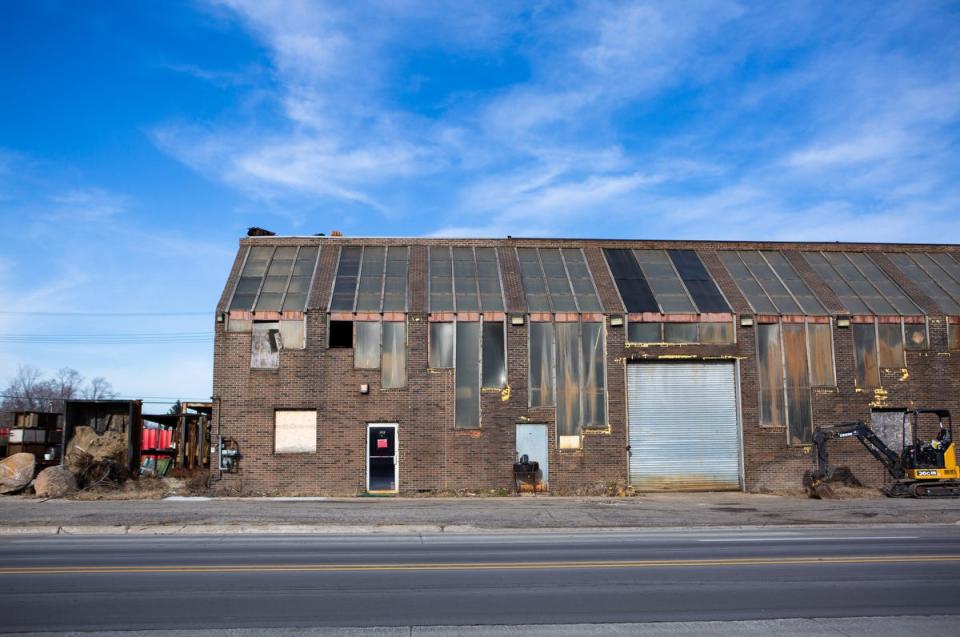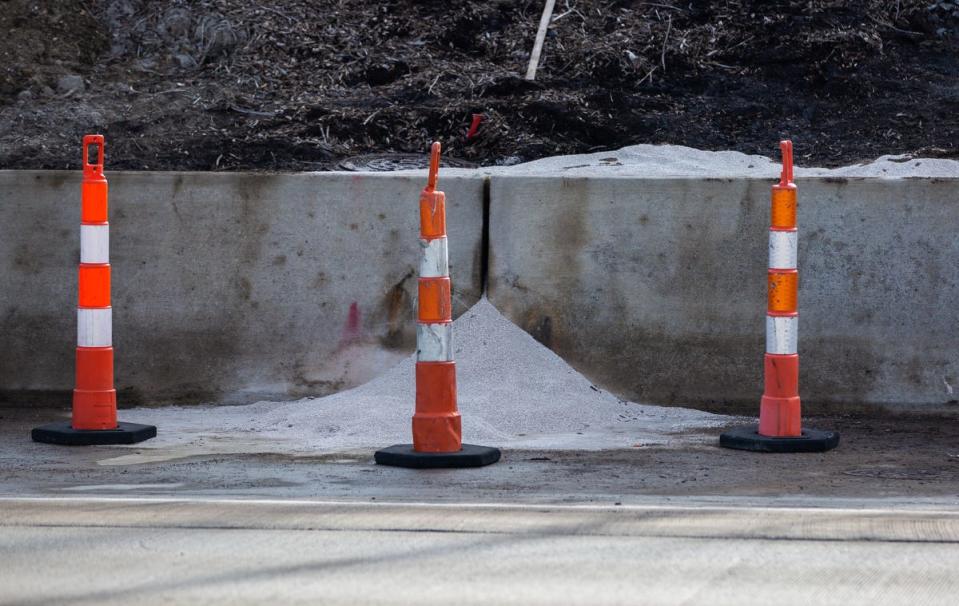Green ooze spilled onto a Michigan highway from this factory – photos inside are shocking
DETROIT – It was no merry splash of holiday color when a bright-green liquid gushed from a freeway wall onto Interstate 696 in Michigan during Friday’s rush hour.
The green gusher backed up thousands of motorists, requiring first a one-lane closure, then two lanes – likely to last at least through this week. Yet those were comparatively minor problems.
Far more worrisome has been deciding what’s in this grinchy gift, how much area did it contaminate, and why wasn’t this gusher choked off last year when the U.S. Environmental Protection Agency spent $1.5 million cleaning up the source of the pollution.
According to a state of Michigan official at the site Monday, last year’s cleanup removed the “imminent threat” to health and safety. But investigators didn’t figure on the basement of the factory gradually becoming a hidden reservoir of contaminated liquid, growing with rain and groundwater to become a small geyser seeking an outlet.

The source is a defunct metal-plating firm, sitting on the service drive above the freeway. Its owner must report to federal prison by mid-January after pleading guilty Nov. 6 to pollution violations.
'You don’t want to go in that building'
In the lengthy investigation that led to the arrest of Gary Sayers, state and federal officials declared that the factory Sayers inherited from his father was a Superfund site, and the cleanup took nearly a year.
Climate change: Were the predictions we made 20 years ago accurate? Here's a look

Yet over the weekend, emergency crews pumped thousands of gallons of the sickly green liquid from beneath Sayers’ former factory. And then, environmental experts issued a dire early analysis: the green liquid likely was groundwater contaminated with highly toxic hexavalent chromium, also known as chromium-6.
It’s the same chemical that a giant California utility let contaminate drinking water, according to a lawsuit brought by activist Erin Brockovich, whose David vs. Goliath battle became a movie in 2000 starring Julia Roberts.
“You don’t want to touch it – you don’t want to go in that building,” said EPA investigator Tricia Edwards, at the site on Monday.
She was one of dozens of state and federal workers who canceled holiday vacation plans to pounce on a site they thought was safe. Although the green gusher posed no immediate risk to the public, largely because no one for miles around gets water from a well, investigators said the return of obvious contamination at the site was a shocking disappointment.
Sayers could not be reached Monday. He was at the site of his defunct business on Friday night, signing a release so that a pollution cleanup crew could enter his property, a state environmental spokeswoman said.
Paul Tamm, who co-owns Tam-Kor Engineering across the street, said he'd known Sayers for years, considers him a friend and that "he's not a criminal – he's just eccentric."
But while patrons at a nearby bar were joking about naming a new drink “green slime,” state and federal pollution investigators were trying to assess how the spill had erupted.
In the basement of the former Electro-Plating Services, “Gary Sayers hand-dug a pit – he told me himself,” recalled Tracy Kecskemeti, district coordinator in Southeast Michigan for the state’s newly renamed environmental agency – the Michigan Department of Environment, Great Lakes, and Energy (EGLE). Kecskemeti interviewed Sayers as part of the state and federal investigations into his pollution violations. He was sentenced in November to a year in federal prison.
The pit was roughly 10-by-10 feet and “five or six feet deep,” Kecskemeti said Monday. Its bottom? Just dirt.
“And while he was operating there, for many years I believe, he had all of the liquid waste flowing into that pit. Every so often, he would pump out that pit into a tank, filter it and run it into the city sewers,” she said.
During the EPA’s cleanup, the pit was fully emptied, as were every tank, vat, barrel and can of dangerous chemicals in the factory. Then cleanup contractors filled the pit with gravel to stabilize it.
But Kecskemeti now says it must have gradually filled with water, which leached into the pit from above the clay layer underground, and also likely flowed into the factory’s basement from rain coming through holes in the deteriorating roof. The water mixed with pollution residues embedded in the earth around the pit, turning it green.
In 2017-18, the EPA cleanup was conducted as a “removal” of “imminent threat” to health and safety, but once it was done, the site was turned over to state pollution experts to decide whether more money and effort was needed for “remediation,” Kecskemeti said.
The initial $1.5 million “was not intended to clean up everything,” she said, adding: “We knew there was contamination in the soil," which would need to be addressed eventually; but because there was no threat to drinking water or otherwise threaten public health, "the site did not meet the criteria for a Superfund listing."
“What this incident shows us is that we didn’t have a full sense of what was underground,” she said. As water accumulated in the basement pit, pressure built up and suddenly, perhaps through some fissure in the soil, a subterranean stream of green began pushing out from under the old factory.
It may have found low resistance in the sand and gravel underlying the adjoining freeway service drive, then reached the perfect route into the freeway – a trench filled with pea gravel that carried an electrical conduit to the side of the freeway, for the convenience of MDOT work crews needing to illuminate temporary signs.
“Right where that conduit comes out of the wall” is where the green gusher erupted, Kecskemeti said.
The EPA expects to know by Friday just what the liquid contains, state and EPA officials said. According to a news release from EGLE, “there is no immediate threat to air quality or drinking water from this release (and) there are no nearby drinking water wells that would be affected from contaminated groundwater."

Unfortunately, hundreds and perhaps thousands of gallons of the contaminated green liquid probably ran into storm sewers and, ultimately, Lake St. Clair before cleanup crews arrived late Friday night. Macomb County Public Works Commissioner Candice Miller commended the quick response by state and federal agencies while also saying that the incident points out the need for a coordinated monitoring plan to protect Great Lakes water.
“Michigan EGLE and EPA were quickly on the job and engaged in this cleanup on what was essentially a holiday weekend," Miller said. She called for the capture and treatment of all pollution that runs into storm drains on major freeways.
“A single drop of this chromium-6 contamination that might enter the lake is one drop too much,” she said.
Contact reporter Bill Laitner: blaitner@freepress.com
If it's cold for you, it's cold for them: Here's how to keep dogs safe in frigid weather
Forget the plastic straws: California cafes are disposing of, well, disposable cups
This article originally appeared on Detroit Free Press: Green slime on I-696 in Michigan: Chromium-6 came from this factory

